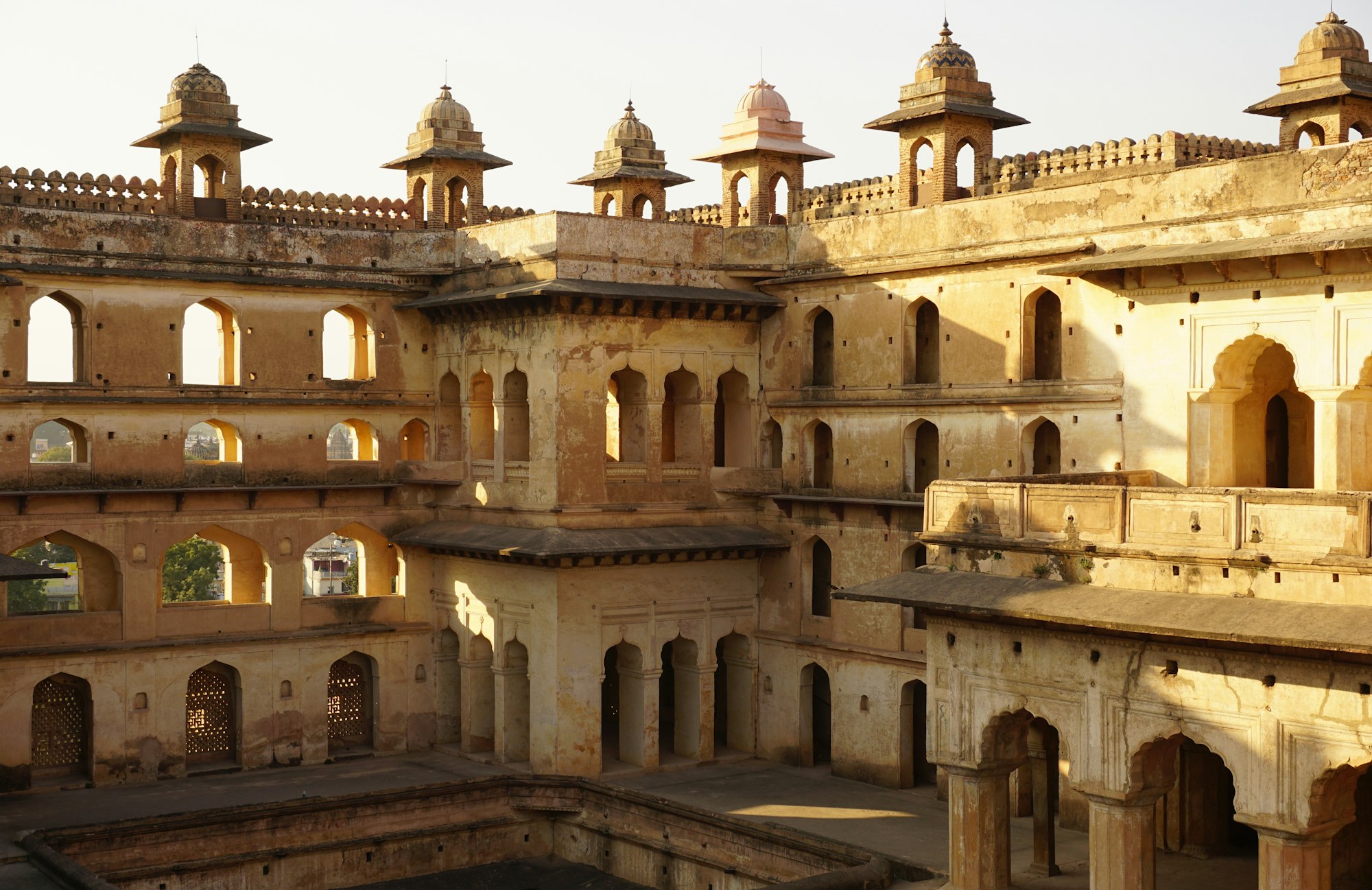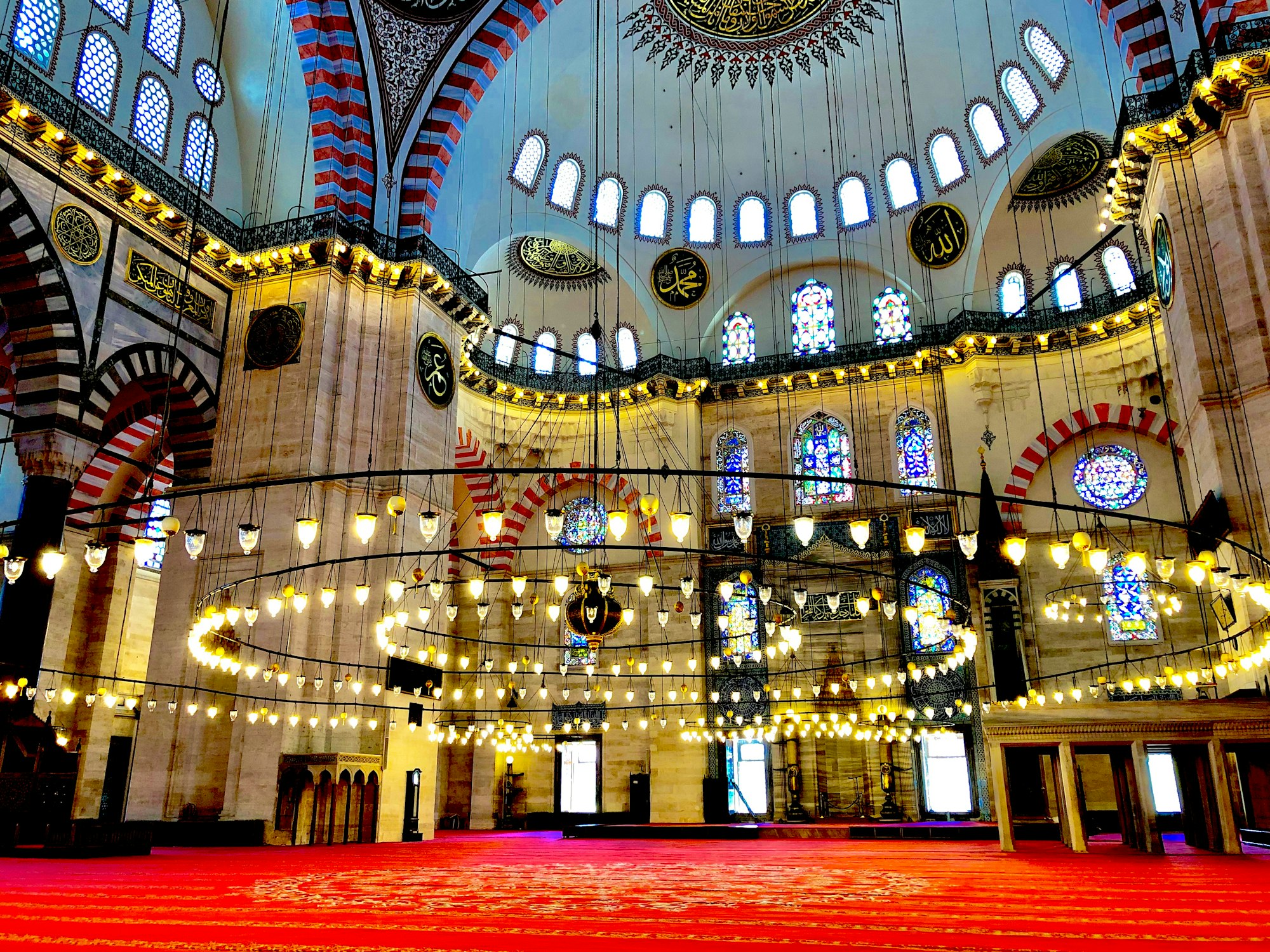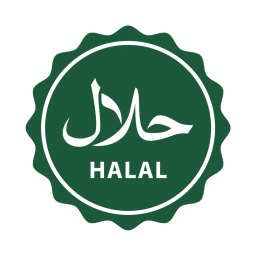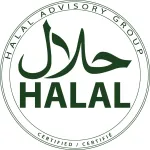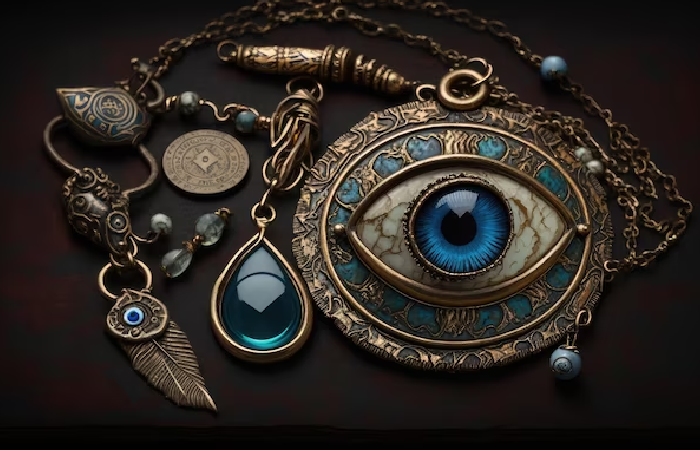Arabic Calligraphy- A Blend Of Beauty And Art
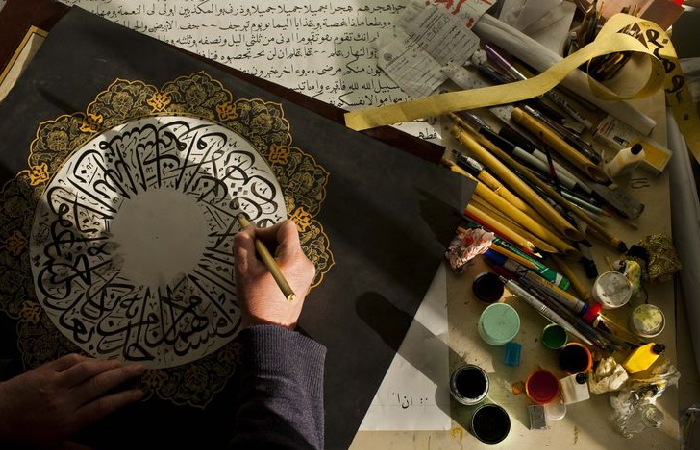
The creative practice of handwriting and calligraphy based on the Arabic script is known as Arabic calligraphy. It is a highly valued art form that is widely used in Islamic art. It is a visual expression style that communicates ideas and feelings using ornamental text, symbols, and visuals. Furthermore, Arabic Calligraphy represents the religious and political art genre. It also depicts the elegance of the written words.
Brief History Of Arabic Calligraphy
Arabic calligraphy was originally used for communication, but it has since been used in architecture, decoration, and coin design. Its evolution into these major roles reflected the early Muslims' need to avoid, as their beliefs required, figures and pictorials that were used as idols prior to the establishment of Islam in the Arabian Peninsula.
-
Archeologists have discovered inscriptions that show a close relationship between Arabic scripts and some earlier scripts, such as the Canaanite and Aramaic Nabataean alphabets that were discovered in the Arabian Peninsula's northwestern region.
-
Arabic Calligraphy is renowned for its significance in the preservation and transmission of the Quran, Islam's holy book. The revelation of the Quran in Arabic elevated the language and its script to hallowed status. Calligraphers precisely copy Quranic verses onto parchment, walls, and other things, transforming the written word into a religious art form.
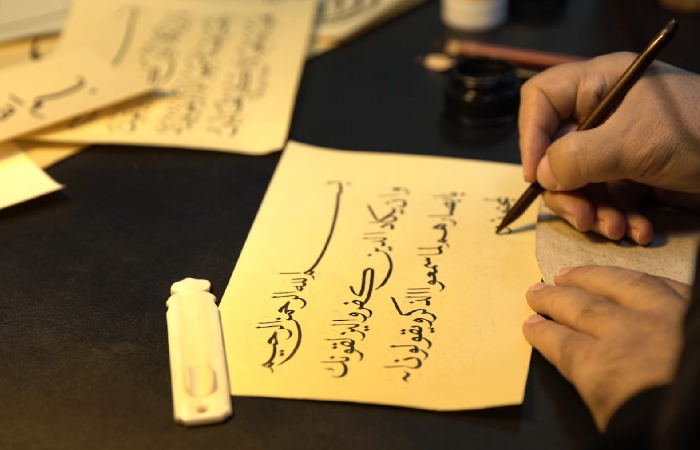
-
The Abbasid era, especially the caliphate of Baghdad, was a golden age for Arabic calligraphy. The art form developed throughout this time period thanks to the patronage of Abbasid caliphs and scholars. Calligraphers created a variety of styles, each having its own features, such as Kufic, Naskh, and Thuluth.
-
The Ottoman Empire was instrumental in improving and developing Arabic calligraphy. Ottoman calligraphers pioneered new forms including Muhaqqaq, Riq'ah, and Diwani, elevating the art form to new levels of grace and complexity.
Significance Of Arabic Calligrahy In Islamic Culture
The Arabic alphabet is most extensively used scripts in the world. Many experts believe that the alphabet was invented in the 4th century CE. The Arabic alphabet consists of 28 letters. These letters are written from right to left. Each letter can be written in four different ways. This depends on where it appears in a word. These four areas are also referred to as the initial, medial, final, and isolated locations.
-
Arabic calligraphy is critical in preserving Islamic beliefs and doctrines. It serves as a beacon, illuminating Islamic ideas and encouraging understanding and reverence. Its innate originality provides a fresh perspective, making Islam's timeless teachings both approachable and artistically appealing.
-
It is a diverse art form with deep roots in Islamic culture. For millennia, its religious, artistic, and intellectual components have impacted Islamic art and culture, and its continuous practice ensures that this wonderful art form will inspire and enchant future generations.
-
Arabic calligraphy is firmly ingrained in Islamic culture, influencing all parts of life. It adorns mosques, homes, and daily objects, serving as a continual reminder of the faith's rich legacy. Calligraphy is another popular art form, with lovers and collectors all around the world admiring its beauty and cultural relevance.
Different styles Of Calligraphy
Arabic Calligraphy is also known as khatt (Arabic) which is derived from the words 'line,' 'pattern,' or 'building.' Kufic is the most ancient kind of Arabic script.
Kufic and Naskh are the two most commonly used scripts for Arabic calligraphy.
Kufic was derived from Iraq and was originally used for stone and metal inscription.
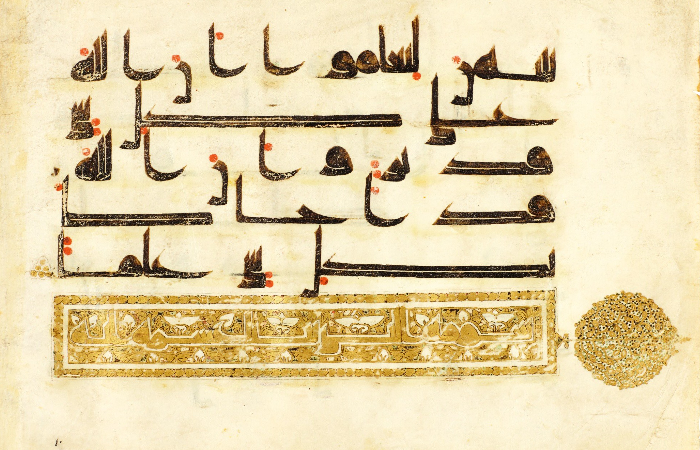
Naskh came from Mecca and Medina. In the 10th century, Naskh Calligraphy was a paragon of intelligibility and grace.
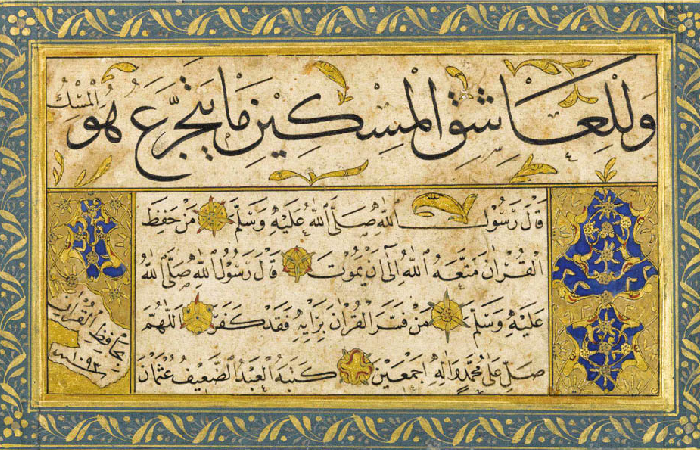
Its smooth and flowing style distinguished it from previous scripts by making it not only visually appealing but also easily understandable.
Other scripts used for Arabic writing include the Thuluth, Nasta'liq, and Diwani scripts.
The Thuluth script: This script was used during the Middle Ages. It is considered to be one of the oldest scripts still in use.
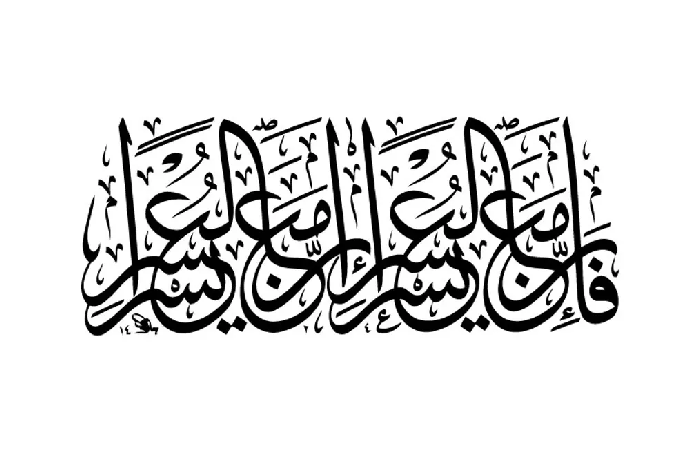
Thuluth's design subtleties are distinguished by prominent left-leaning vertical strokes and beautifully curved horizontal lines, which frequently tangle within individual letters.
The Nasta'liq script: It is used for Persian scripting rather than Arabic scripting. As a result of the steep tilt to the left.
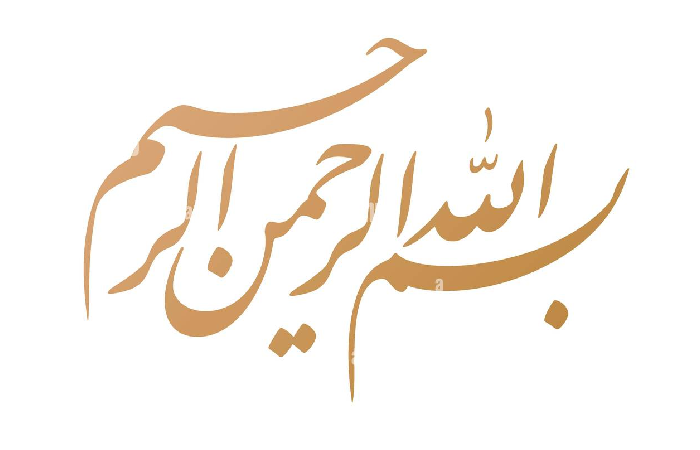
The script is perceived to be distinct from the others. The cursive look creates an appealing appearance.
Diwani Script: During the Ottoman era, the Diwani Script was developed. When writing, the lines and lettering of this script convey a sense of proximity.
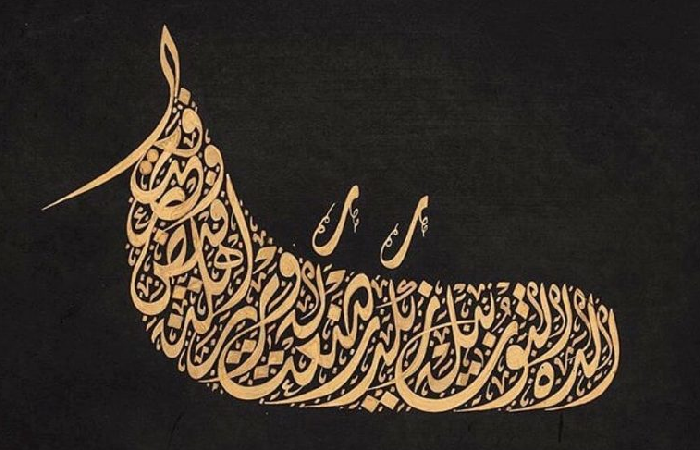
Because the letters are intertwined, it is difficult to read.
These are just a few examples of the numerous forms of Arabic calligraphy. Each style has its own unique charm. They are used to generate a variety of different effects.
Arabic calligraphy is a sophisticated and demanding art form which is extremely rewarding. With practice, anyone can learn to calligraph and create their own works of art.
The Art and Techniques of Arabic Calligraphy
Arabic calligraphy is the creative discipline of writing Arabic script in a fluid manner in order to express harmony, grace, and beauty. The practice that can be passed down through official and informal instruction.
Fundamental Elements Of Arabic Calligraphy (letters, dots, lines)
Arabic is written and read left to right. Upper- and lower-case letters are not distinguished. Letter shapes typically differ depending on whether they are in an initial, medial, or final position in a word.
Punctuation marks did not become common until the twentieth century. Short vowels, denoted by a series of signs beneath or above the letters, aid in word pronunciation. These are often only printed in the Qur'an, where perfect recitation is vital, and works for novice readers.
The Arabic alphabet is made up of eighteen forms that use diacritical symbols to describe twenty-eight phonetic sounds.
Kufic Script:
Kufic was the first calligraphic script to achieve popularity in Qur'ans, architecture, and portable works of art, with angular letters, horizontal format, and broad prolonged strokes. Kufic variants eventually arose. Letters entwined with floral adornment (floriated kufic) to letters that appear to be braided into knots (knotted/plaited kufic) are examples.
Proportional Script:
From the eleventh to the thirteenth centuries, a new system of proportional cursive scripts was codified. Each letter's shape in a proportionate script is regulated by a predetermined number of rhombic (diamond-shaped) dots.
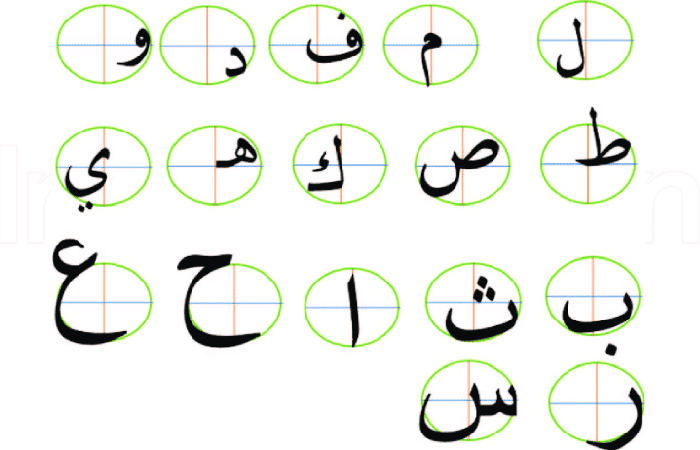
A rhombic dot is made when a calligrapher presses his or her pen to paper in a downward motion, forming a diamond shape.
The letters in a word written in one of the proportional scripts can vary in size, but they will always be in strict proportion to one another. The Six Pens are six proportional scripts: Naskh, thuluth, muhaqqaq, rayhani, tawqi', and riqa'.
Regional Variations and Scripts:
Scripts have their own role and history. some were extensively utilized, while others remained local. Maghribi, for example, emerged and was largely used in Spain and North Africa, whereas nasta'liq, a flowing script that originated in Iran and Central Asia, migrated eastward and became popular in Mughal India and Ottoman Turkey.
The Aesthetic Principles And Practices
Balance And Harmony: In the overall composition, Arabic calligraphy emphasizes balance and harmony. The proportions of the letters, the spacing between them, and the overall flow of the script are all carefully considered by the calligrapher. The idea is to create a composition that is visually appealing and well-balanced.
Legibility: In addition to aesthetic beauty, Arabic calligraphy should be legible. The calligrapher must make certain that the letters are correctly shaped and easily identifiable. This is especially true when trancribing holy writings like the Quran.
Rhythm and fluidity: Arabic calligraphy is noted for its fluidity and rhythm. The strokes of the calligrapher should be smooth and graceful, and the letters should flow together in a rhythmic dance. This gives the calligraphy a sense of movement and vigor.
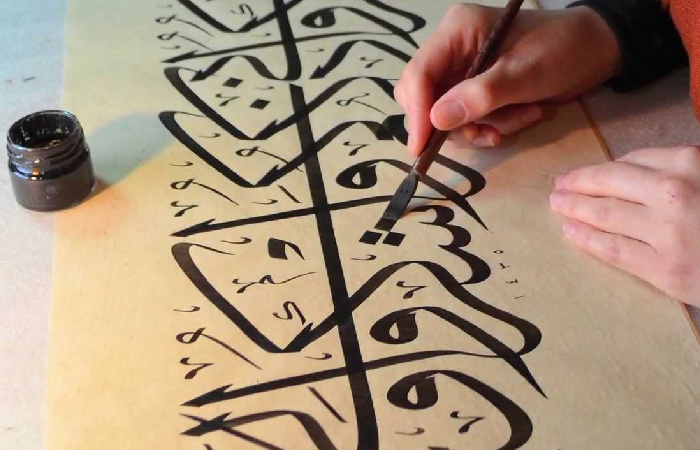
Unity and Cohesion: The individual letters in an Arabic calligraphy piece should not stand out as distinct parts. They should instead collaborate to foster a sense of unity and coherence. The relationship between the letters and how they contribute to the overall design should be carefully considered by the calligrapher.
Expression and Meaning: Arabic calligraphy can convey a wide range of emotions and meanings. The calligrapher's script choice, stroke thickness, and overall composition can all convey distinct messages. A calligraphy piece written in a forceful, angular script, for example, may express a sense of power or strength, whereas one done in a delicate, flowing script may convey a sense of calm or tranquility.
The choice of tools , preparation of surface and practice of patience all play a vital role in Arabic Calligraphy.
Arabic calligraphy ideas and methods are hard and demanding, but the benefits are well worth the effort. Anyone can learn to make their own magnificent works of Arabic calligraphy with patience and effort.
Tools and Materials Used In Traditional Calligraphy
The tools and materials used have an impact on the final product's quality. Every calligrapher learnt how to make pens, inks, and paper. Due to their flexibility, reeds were frequently used to make pens (qalam).
-
First, hollow reeds were gathered and dried before the calligrapher cut a tip in the form, width, and angle that best fitted the script he or she intended to use.
-
Natural elements like soot, ox gall, gum Arabic, and plant essences were used to make inks. Manuscripts were written on papyrus and parchment (animal skin) before paper was introduced to the Islamic world from China about the eighth century.
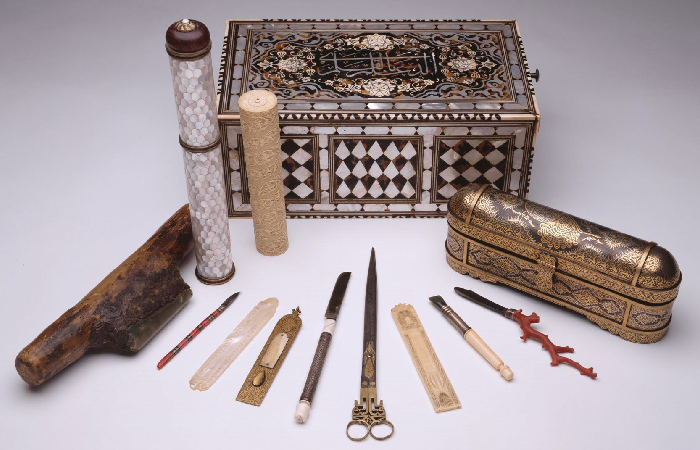
-
Because calligraphy was regarded as an art form, the equipment associated with it—shears, knives, inkwells, and pen boxes—were frequently ornately designed.
-
The fluidity of Arabic writing allows for endless possibilities, even within a single phrase, as letters can be stretched and changed in a variety of ways to produce distinct themes.
-
Traditional techniques employ natural materials for the qalam, or writing instrument, such as reeds and bamboo stems. The ink is created from honey, black soot, and saffron, while the paper is handcrafted and processed with starch, egg white, and alum.
Tools Used In Arabic Calligraphy
Arabic calligraphy instruments differ from those used for traditional or modern calligraphy. While classical calligraphy requires a nib, nib holder, and ink, Arabic calligraphy pens are typically composed of reeds and rigid wood.
The following are some of the most commonly used implements and supplies in Arabic calligraphy:
Qalam Pen
The Qalam pen, which is constructed from a cut, dried reed, is the most commonly used pen for Arabic calligraphy. In Islam, this pen is regarded as a symbol of wisdom.
Khamish Pencil
A khamish pen, also known as a reed pen, is commonly used by Arab, Turkish, and Iranian calligraphers.
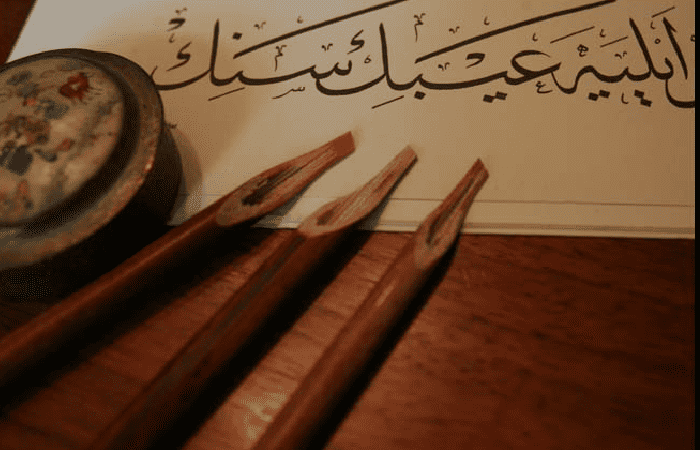
It is manufactured from reeds that grow near rivers, but it must cure for a long time before it can be used for calligraphy.
Bamboo Pencil
The bamboo pen is one of the world's earliest calligraphy utensils. Bamboo is an excellent material for Arabic calligraphy because its stiff edge allows calligraphers to execute the entire range of pen movements while also providing some flexibility.
The Java Pen
Java pens are produced from a species of thorngrass native to Java. They're well-known for their stiffness and ability to make letterforms with a sharp edge. This pen is particularly well suited for short scripts.
Handam Pen
The Handam pen is one of the most adaptable pens for Arabic calligraphy, and it comes in a number of sizes, from a huge 10mm variation to a sub-1mm tiny nib.
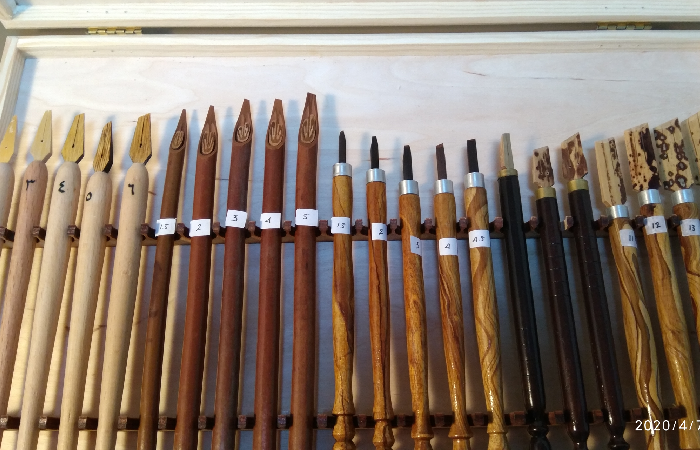
This makes it appropriate for a wide variety of scripts. Furthermore, it has a high level of durability: you don't have to cut or sharpen it as frequently as a Khamish pen.
Celi Pen
Celi pens are designed for large-scale Arabic calligraphy. The nibs are made of bamboo and have ink reservoirs integrated into them.
Ahar Paper
While many other types of paper can be used for Arabic calligraphy, there is one specifically designed for the art form. Ahar paper is manufactured by hand in central India. It is covered with a combination of starch and an alum and egg white sizing. This glossy layer prevents ink from permeating the paper. Instead, the ink sits on top of the coating, allowing calligraphers to erase and fix their work.
Ink
Traditional Arabic calligraphy ink is soot-based and water-soluble, so any mistakes may be removed with a damp towel. While black is the most common ink color, a range of other ink colors are now available and commonly utilized.
Modern Calligraphy,
- Markers and synthetic paint are often utilized.
- Spray paint is used for calligraffiti on walls, signs, and structures.
- Arabic calligraphy is frequently used by artists and designers to enhance their work.
- Often seen on marble and wood carving, embroidery, and metal etching.
- It is widely practiced by men and women of all ages in Arab and non-Arab countries.
- Skills are passed down informally or through formal schools or apprenticeships.
While Arabic calligraphy is deeply rooted in history, it also provides as inspiration for contemporary art. In reality, several contemporary artists have established their own Arabic calligraphy style and techniques.
Modern artists may put their own touch on conventional letterforms and mediums, such as combining calligraphy into jewelry and digital designs, or painting on canvas instead of ink on paper.
Arabic Calligraphy in Islamic Art
Arabic calligraphy has progressed from a practical art form to a visual representation of beauty and harmony. Calligraphers use a variety of styles, each with their own distinct characteristics, to create visually spectacular works that adorn mosques, manuscripts, and everyday objects.
Arabic calligraphy's fluid strokes, sophisticated ligatures, and harmonious compositions exemplify Islamic art's aesthetic principles. Calligraphers expertly alter Arabic script, transforming it into a hypnotic dance of lines and patterns.
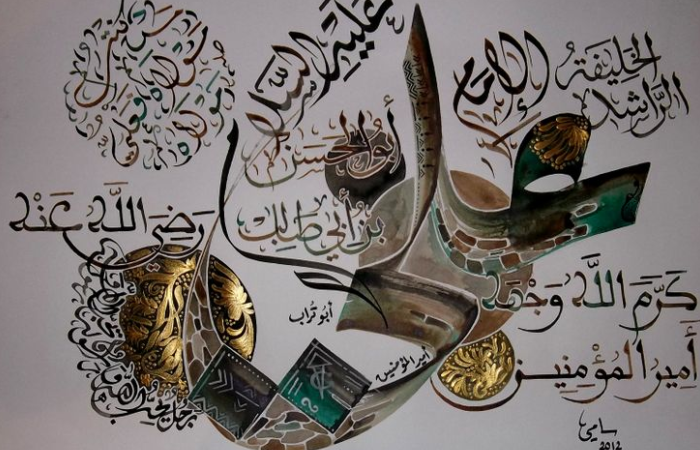
Calligraphers are frequently scholars and masters in Islamic literature, imbuing their work with layers of meaning and symbolism. The choice of script, letter spacing, and overall composition can convey profound spiritual and philosophical ideas.
The Role Of Calligraphy In Islamic Architecture And Décor
Arabic Calligraphy is an important decorative feature in Islamic construction, as well as a means of expressing religious and cultural ideas. Calligraphy can be seen embellishing different architectural constructions throughout the Islamic world, from mosques and palaces to tombs and public buildings.
Mosques:
Calligraphy is frequently used in mosques to engrave verses from the Qur'an and other religious literature on the walls, mihrab (prayer niche), minbar (pulpit), and domes. These inscriptions serve as a constant reminder of the divine and aid in the creation of a spiritual environment for worshippers.
The Great Mosque of Kairouan in Tunisia and the Alhambra in Spain are two outstanding examples of mosques with significant calligraphic embellishment.
Mausoleums and Tombs:
Calligraphy is also used to decorate tombs and mausoleums, generally inscribing the names of the deceased and their titles, as well as Qur'anic texts.

The Taj Mahal in India is a great example of this, with its magnificent calligraphic inscriptions on the outside and interior.
Palaces and Public Structures:
Calligraphy is used in palaces and other public structures not just as a beautiful feature, but also to assert power and authority.
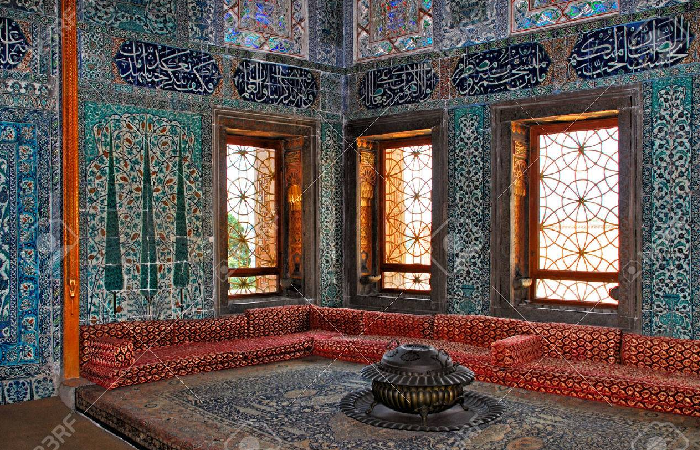
For example, the Topkapi Palace in Istanbul is covered with calligraphic inscriptions extolling the virtues of the Ottoman sultans.
Architechtural Elements:
Friezes, arches, and decorative panels are also embellished with calligraphy. To create visually appealing designs, calligraphy is occasionally combined with other artistic techniques. These include various geometric patterns and arabesques.
Finally, calligraphy plays a significant role in Islamic art and architecture. As a visual depiction of the divine. It functions as both a decorative feature and a means of teaching religious and cultural values. The use of calligraphy into architectural structures emphasizes both the beauty of Arabic script and the craftsmanship of those who have transformed it into an enduring icon of Islamic civilization.
Mosques and Historical Buildings with Iconic Calligraphy
The Great Mosque Of Cordoba
In 784-786, the Umayyad monarch Abd al-Rahman I built the first sections of the Great Mosque of Córdoba, Spain, on the site of a Christian church. In the ninth and tenth century, the structure was expanded multiple times. A lavishly decorated mihrab (a niche in a mosque oriented toward Mecca) situated behind an elaborate arch was added during one of these enlargements.
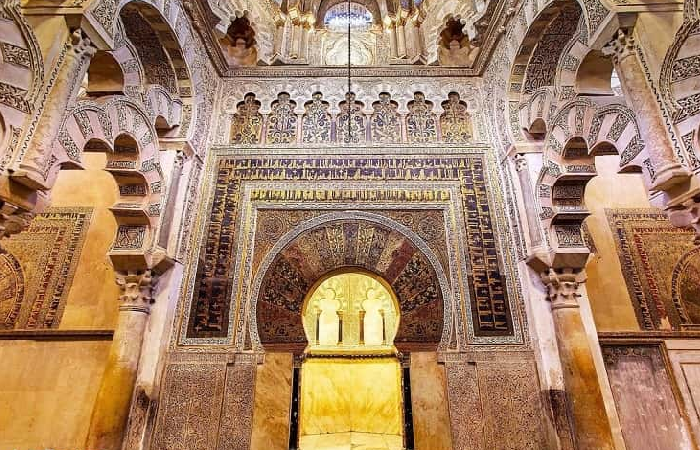
The hypostyle hall, which contains roughly 850 columns made of porphyry, jasper, and marble and supports two-tier horseshoe arches, is another notable element of the mosque. The majority of the columns and capitals were reused from previous structures.
The Alhambra Palace:
The Alhambra is a palace built in the 14th century by Muslim Nasrid dynasty princes (1238-1492). It is located on a hill with a view of the Spanish city of Granada.
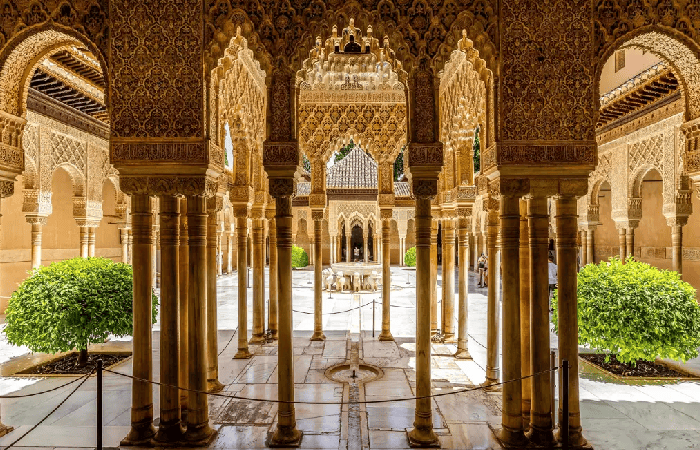
Although several of the palace's components have been demolished, three remain: a fortress (Alcazaba, or al-Qasbah) on the western extremity of the hill, a princely mansion to the east, and the Generalife, a collection of pavilions and gardens. The courtyards and chambers of the Alhambra are beautifully embellished with colored tiles, carved plaster, carved wood, and calligraphy.
Among the most notable ornamental characteristics are the magnificently carved geometric stalactite decorations (a recurring pattern in Islamic architecture called muqarnas in Arabic) that adorn the rooms around the Court of the Lions.
The Suleymaniye Mosque Complex:
The towering dome and minarets of the Suleymaniye Mosque complex are among the most conspicuous features of the Istanbul skyline. They rise on an artificial platform overlooking the Bosporus. This is the largest and possibly the most beautiful of Istanbul's imperial mosque complexes.
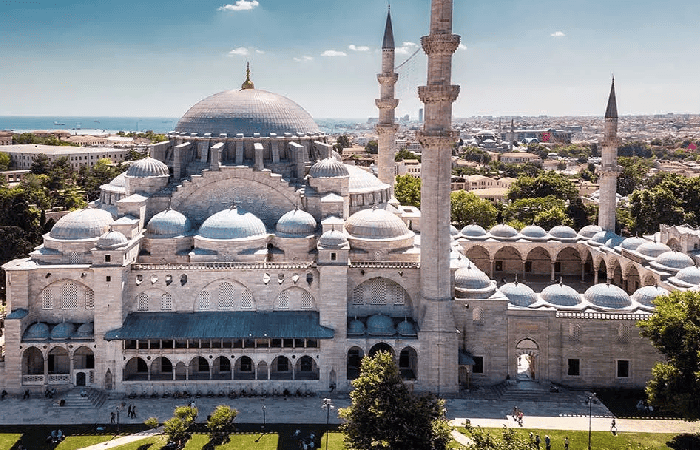
Built between 1550 and 1557 at the height of the Ottoman Empire's strength by Ottoman sultan Suleyman the Magnificent. The mosque's interior is a single square-shaped space with over 100 huge windows, many of which are stained glass. The decoration is basic and does not detract from the central dome's magnificent size of 90 feet (27.5 meters).
A hospital, various religious schools, a row of shops, a tomb, and a bath are located surrounding the mosque. The complex was created by the Ottoman master architect Sinan, whose works were crucial in establishing a distinctly Ottoman style of architecture, and is considered one of his finest. Sinan and Suleyman are both buried in the complex.
Digital Evolution Of Arabic Calligraphy
Digital Arabic calligraphy is a calligraphy style that combines traditional lettering with modern computer technologies.
It is a style of art that helps artists to construct intricate designs. These designs convey emotion, culture, and history.
This kind of calligraphy is existing for the past 20 to 30 years. But it became accessible to the general people now as technology has advanced.
It is now possible to create digital Arabic calligraphy using software. Sites like www.emashq.com make it easier to create distinctive and complex designs.
Arabic Calligraphy Generators
The Arabic Caligraphy Generator is a free online application that changes your or a loved one's name from Latin characters to Arabic text (Arabic cursive) with beautiful Islamic calligraphy.
Create your name, favorite Q'uran phrase, or any other Islamic text on T-shirts, mugs, tattoos, posters, necklaces, store signs, stickers, cards, letters, and protest signs using the Arabic Calligraphy Generator. Create personalized caligraffiti with your own name or other phrases to beautify a room or a wall in your home.
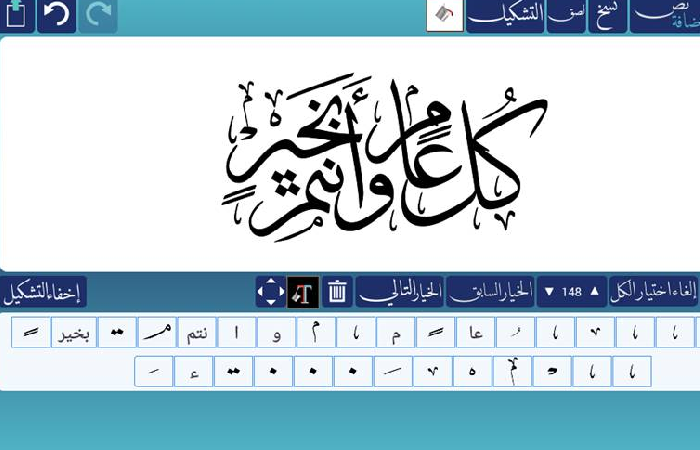
How Generators Work And Their Applications?
By using a generator, you may find almost any type of calligraphy font. The idea behind a generator is to use several fonts and experiment with them. Or use them to create calligraphy written art pieces.
-
All you have to do is search for the font style you want on the internet. Download the calligraphy generator app. Once it is downloaded, you will have instant access to your very specific type of calligraphy.
-
You can find a free online calligraphy generator too. You can download apps for more complicated or custom fonts. From there, you can do a variety of things with the calligraphy. For example, the fonts can be printed out so you can practice creating them free-hand.
-
If you're more advanced, you can utilize the printed calligraphy fonts with a light box for tracing and faster free-hand learning. Consider a calligraphy generator to be a pattern you can use to learn or master a new font style.
-
The amazing thing about it is that you can change the text size to suit your needs. It provides you with a personalized template from which to operate.
-
You can also make tools for later use, such as calligraphy artwork or a stencil, so that you can always pick up and use your favorite font style.
-
After you've chosen your font, put what you want written in calligraphy into the generator and save it as a PDF. You now have a personalized piece of calligraphy that may be used in an almost unlimited number of ways.
-
You may make incredible, one-of-a-kind gifts for anyone by putting in someone's initial name, family name, inspirational message, or anything else and stenciling or painting it on the cover of a notebook, picture frame, or using it as an actual framed piece of artwork.
Pros And Cons Of Using Digital Tools For Calligraphy
It is not necessary to employ a calligrapher or master difficult calligraphy software. Anyone can use our online tool to produce beautiful Arabic calligraphy.
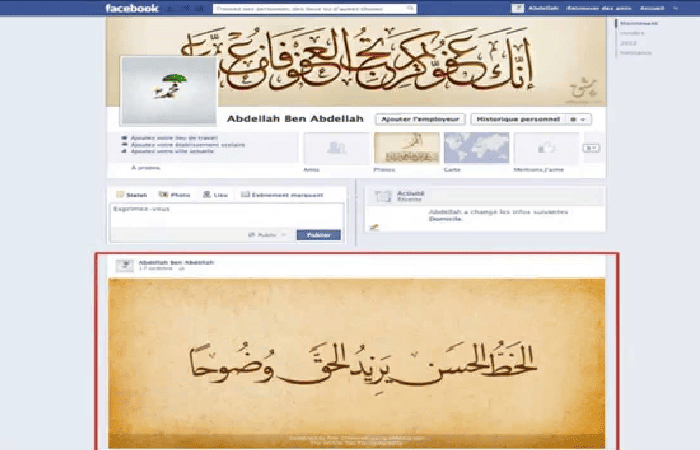
Simply enter your text, select your font and size, then click generate. You'll get stunning Arabic calligraphy in seconds that you can download and use in your creations. The nicest aspect about this online application is that it provides you with over 10+ free background textures to choose from.
So, whether you want to personalize your wedding invites or create a professional logo with an Arabic twist, our free calligraphy generator is the tool for you. Give it a shot right now!
The Flip Side
Learning curve: Because you will need to learn how to utilize the software and hardware, digital tools may have a higher learning curve than traditional ones.
Technical problems: You may encounter technical problems such as program crashes or hardware breakdowns, which might hinder your workflow.
Eye strain: Working on a computer for lengthy periods of time can create eye strain.
Loss of tactile sensation: Digital tools lack the tactile experience that some calligraphers love while using traditional instruments.
Limited Customization: Digital tools do provide a wide range of options. But they may not provide the same amount of personalization as traditional tools.
Dependence on technology: You will be reliant on technology to develop your work. This might be frustrating if you run into technical problems.
Top Arabic Calligraphy Generators Available Online
- https://www.diwan.com/index.php/products/apps/102-ana-muhtarif-al-khat
- https://best-arabic-calligraphy.en.softonic.com/android
- https://arabicnamegenerator.com/

Islamic Calligraphy Wall Art
Islamic wall art is probably the best available representation because of its spectacular use of colors and superb sense of balance in Islamic shapes and forms. It makes an immediate visual impression as well as a powerful aesthetic impact.
Trend And Cultural Significance Of Islamic Calligraphy In Home Décor
Islamic wall art does not transmit an artist's thought, rather, it brilliantly and artistically communicates the word of the Almighty, the greatest of all Artists, to His beings.
Walls are simply constructed of bricks or concrete and have a dreary appearance when left plain, but when they are covered with Islamic wall art, they take on new life, a brilliant appearance, and undoubtedly become a symbol deserving more respect.
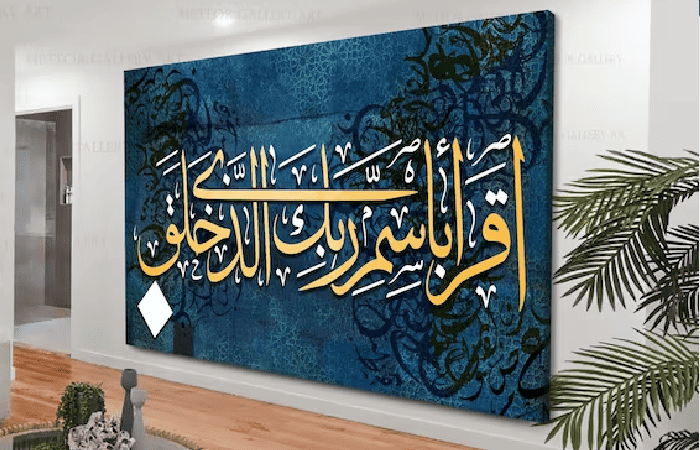
Calligraphy is a prominent component of Islamic wall art, and it is used to write verses from the Holy Quran, Adkar, Asma ul Husna, Asma ul Nabi, Duas, and many other things. Many kinds of Islamic wall art Arabic calligraphy, such as Naskh, Thuluth, Nastaliq, and others, are used in selecting subjects and designing the creative piece of work.
Various forms of Islamic calligraphy wall art
Islamic wall art is a traditional method of adorning living spaces such as houses, apartments, and hotels, as well as professional environments such as schools, companies, libraries, shopping malls, and so on. This greatly improves the ambience, brings serenity to the surroundings, harmonizes the inner world, and brings peace of mind in a hectic life.
-
People nowadays choose to use Islamic wall stickers, wall hangings, and other such items in their lodgings because they are more convenient, take up less room, are less expensive, and are easy to use.
-
Previously, people kept paintings, some metallic works, engravings, and carvings, but the trend in western countries has changed with the little modification in Islamic art while adhering to the main roots of Islam is the main emphasis point.
-
As a result, the use of Islamic wall arts is now increasingly prevalent among Muslims all over the world. The incorporation of arts into daily life is regarded as one of the historic Islamic world's customs.
-
The idea is that, just as Islam is fundamental to all elements of a Muslim's life and makes them enjoyable, Islamic art should be used to make everyday life more beautiful.
DIY Tips For Creating Your Own Islamic Calligraphy Wall Art
Making your own Islamic calligraphy wall art is a lovely and meaningful way to show your beliefs while also beautifying your house. Here are some starting points:
1. Decide on a design:
There are numerous styles of Islamic calligraphy available. Kufic, Naskh, and Thuluth are popular styles. You can also get ideas from Islamic art books or the internet.
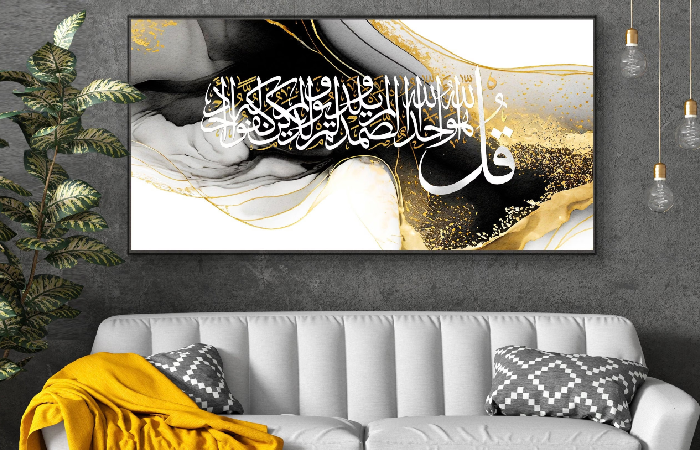
Collect the following materials
You will need the following supplies to make your own Wall Art:
- Paper or canvas of your choice. Watercolor paper is a wonderful choice for beginners because it is absorbent and forgiving.
- A calligraphy pen, a paintbrush, or even a marker.
- Choose a color that will stand out against the chosen background.
- You also need a Ruler, pencil and eraser
2. Work on your lettering:
Practice your lettering on scrap paper before starting on your final design. This will allow you to become acquainted with the feel of the pen or brush and confirm that the appearance of your letters is satisfactory.
3. Copy your design:
When you're satisfied with your practice lettering, you can transfer it to your final piece of paper or canvas. You can achieve this by either freehand tracing your design or utilizing a light table.
4. Add color and embellish:
After your design has been transferred, you may begin adding color and details. Painting, gilding, and decorating with glitter or beads are just a few of the options available.
5. Display your artwork in a frame:
When you're satisfied with your artwork, frame it and hang it on your wall. This will assist to protect your artwork and make it look more polished.
Learning Arabic Calligraphy
The five basic shapes required to write in Arabic calligraphy.
1. Vertical Stroke
You may make a straight vertical stroke by pulling your pen downwards. Depending on the characters you use, this shape can be used in a long or short version.
2. Horizontal Stroke
To make a horizontal stroke, drag your pen from left to right.

3. Oblique Stroke
Pull your pen down at an angle, resulting in a gentle curve that ends in a horizontal stroke that lies above the line of your paper.
4. Circle
Form your circle with two strokes, just as if you were sketching rounded parentheses pulled together. Then, to make the transition look smoother, apply ink to the points where they meet.
5. Returning Tail
Create a line that looks like a tilde (~), then from the left side extend it into a downward curve.
Tips for Beginners
With its magnificent beauty and long legacy, Arabic calligraphy is a compelling art form to explore. Whether you're drawn to it for its spiritual meaning or artistic expression.
Going on this creative journey may be both satisfying and enriching. The first steps, however, may appear difficult to beginners. Not to worry! Here are some helpful hints to get you started on your calligraphy journey:
Make a Movement with Your Hand
One common mistake is to only move your fingers when designing a character, but moving your hand and wrist can allow you to generate much more fluid lines.
Make Transitions That Are Smooth
Avoid making your curve too sharp, as this can disturb the letter's harmony. Instead, steadily draw and carry the pen to make a smooth, natural-looking curve.
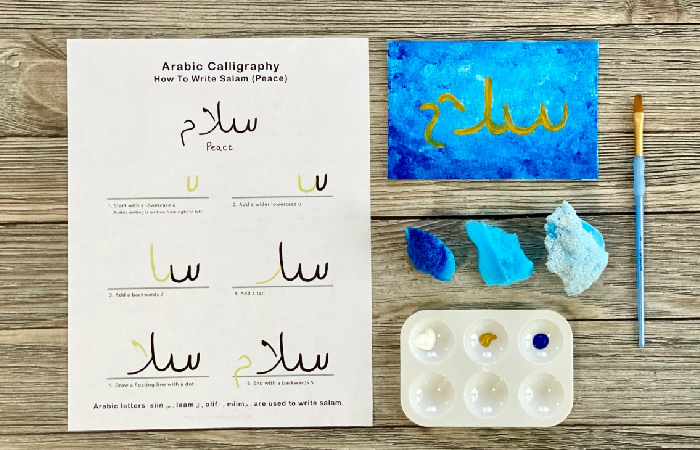
Take Note of the Pressure
You want your line to get thinner as you near the conclusion of the aleph, so pay attention to where you are in the letter and begin lifting pressure off your pen accordingly.
Work from the right to the left.
Text in Arabic calligraphy is written from right to left, so make sure to practice in that way.
Examine Your Strokes
Because a pen can't hold much ink, you'll need to re-dip it repeatedly to fill in your strokes and make firm, dark lines.
Arabic Calligraphy Online Resources and Courses
Here are some helpful online resources and courses to get you started learning Arabic calligraphy:
My Qalam Academy: Provides comprehensive online courses taught by skilled specialists in many forms of Arabic calligraphy.
Udemy: Offers a wide range of online courses in Arabic calligraphy for various ability levels, from beginner to experienced.
Skillshare: Provides a variety of online Arabic calligraphy classes, including particular styles such as Thuluth and Naskh.
Domestika: Offers online training on many areas of Arabic calligraphy, such as Kufic script and digital design software.
FRJ Islamic Art: Offers online courses and workshops for novices, with an emphasis on the Naskh and Thuluth scripts.
https://majnouna.com/courses/
https://www.domestika.org/en/courses/2257-arabic-calligraphy-learn-kufic-script/course
https://www.arabbritishcentre.org.uk/courses/kufic-calligraphy-with-joumana-medlej/
https://medium.com/tag/arabic-calligraphy
Workshops and Classes for Hands-on Learning
- 6 Free Tutorials: Lettering and Calligraphy for Beginners
- Lettering, Calligraphy, and Typography: Do You Know the Differences?
- Why Is Calligraphy So Good for Your Brain?
- Shodo: Introduction to Japanese Calligraphy
- Uncial Calligraphy for Beginners
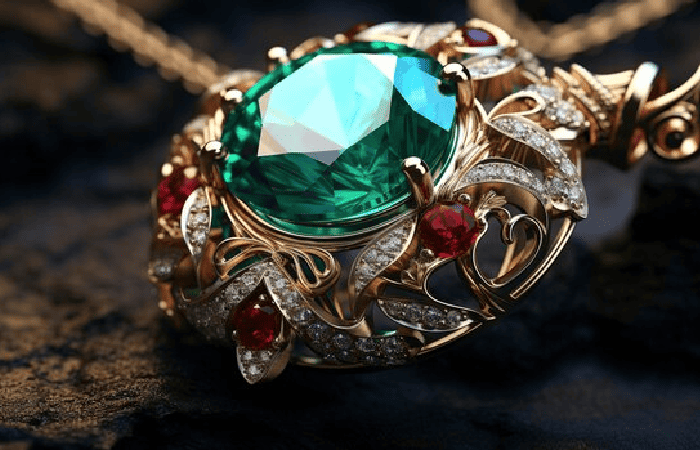
Interviews With Mohamed Zakariya - Renowned Arabic Calligrapher
Mohamed Zakariya, a master calligraphy and artist, is one of today's most well-known calligraphers. He is an American pioneer and diplomat who introduced Arabic script calligraphy to the Western world.
Zakariya hoca (Turkish for instructor) began studying calligraphy in the 1960s and holds licenses in a variety of scripts. He has shown all around the world and received numerous awards for his art. He is perhaps best known for designing the Eid wishes US postage stamp.
His abilities extend to metalwork, machinery, and woodworking. He is also a master of numerous traditional skills, like Ebru (paper marbling) and Tezhip (art of lighting), to name a few.
Exploring His Journey And Work
Zakariya hoca speaks Classical Arabic, Ottoman and Modern Turkish, and Romanian (which he describes as a lyrical language).
He discusses the differences between Islamic and Arabic calligraphy, as well as its contemporary relevance. He also discusses the significance of silsila, or the chain of transmission for calligraphers, and how Ottoman master eyh Hamdullah blended the precision and beauty of writing in calligraphy in the 15th century. He discusses the architecture of calligraphy and how it should feel, and how the two are distinct.
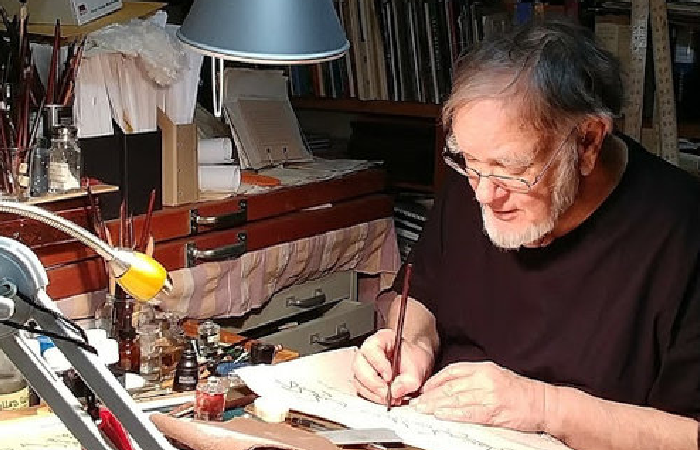
There is no such thing as [pure] Islamic art in the world anymore. Islamic art existed when different countries had an Islamic civilization. We now have national cultures (Iraqi culture, Turkish culture - the culture is tinted by nationality). So you can't say it's entirely Islamic. Of course, it has Islamic characteristics, but when you look at it, the people who were calligraphers back then are completely different from those who are now.
Almost all calligraphy originated from the religious institution; they were raised memorizing the Quran and attending various degrees of [Islamic] school. The majority of them had official positions in the Ottoman state and also worked for commissions.
Hoca went on to say that the father of the Ottoman school of calligraphy, eyh Hamdullah, shaped this approach of instruction and calligraphic transfer from teacher to pupil. He is the one who established how this technique is done and taught. eyh Hamdullah combines accuracy and beauty in an unprecedented way.
The Maghrebi script, a type of North African writing, is one of hoca's specializations. He stated that it is the first script he studied and that he enjoys it, but it is not precision writing like thuluth or naskh scripts.
When you look at a thuluth script writing, you will observe invisible lines going in a given direction with measurements, such as 5 dots or 10 dots.
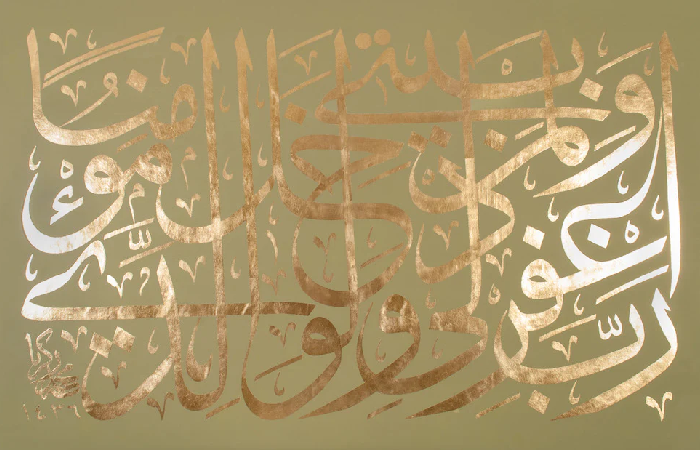
Hoca went on to say, "these relationships of dimensions are only the beginning of writing." As a result, when you first learn how to write in Arabic calligraphy, you are also learning letter measurements.
He stated it was difficult for him at first to fathom how he would make a letter 5 dots (nuktas) every time. However, he stated that his training as a machinist assisted him in conceptualizing the size and precision of a 5-dotted letter, 6-dotted letter, or 10-dotted letter.
"Dots are the architecture of the letters." That's just the beginning. You must have a'breadth-like flow.' It relates to the feedback [you may feel from the paper] as well as the flow of ink. This is pretty difficult."
To me, calligraphy is a journey. You learn the rigorous rules at first, but it quickly becomes more about motion and sensation. You form an emotional bond with the letters.
When you observe Zakariya hoca working on letters, you can definitely understand this.
Other Renowned Calligraphers are:

https://www.jaca2006.org/
https://mohamedzakariya.org/
Upcoming Artists And Their Innovative Approaches
The art of Arabic calligraphy is undergoing a revival. With a new generation of artists pushing the boundaries and experimenting with new ideas. These artists are not only maintaining tradition, but also mixing it with modern elements, resulting in gorgeous and thought-provoking creations.
El Seed, well known for his large-scale calligraffiti murals, mixes Arabic calligraphy with graffiti art. He transforms urban spaces into canvases for his message of peace and understanding by using brilliant colors and powerful typography. His work has been displayed in locations worldwide, including Paris, Dubai, and Cairo.
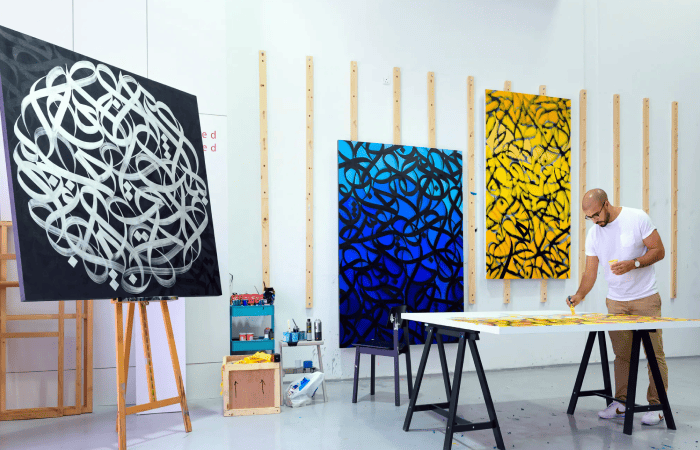
Huda Beydoun's work delves into subjects such as identity, displacement, and the feminine experience. She combines traditional calligraphy components with contemporary art mediums such as video and installation. Her art has been displayed abroad and is held in prestigious museum collections.
Omar Mismar makes digital and interactive calligraphic works. He manipulates and animates Arabic writing with technology, generating captivating and dynamic graphics. His work delves at the intersections between art, technology, and language.
Belal Khaled: Palestinian artist Belal Khaled is pushing Arabic calligraphy to new heights, designing not only buildings but also cars, accessories, streets, and even human skin.
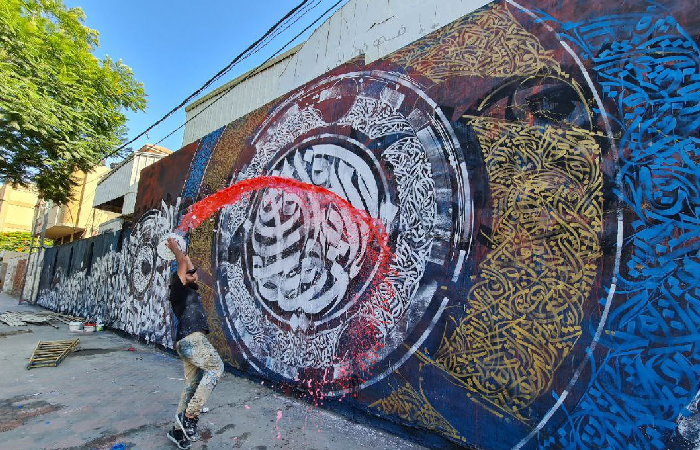
Khaled began embellishing women's accessories with his calligraphic designs for local retail establishments, which proved popular with both retailers and buyers.
Gallery and Inspirations
Arabic Calligraphy Artworks



* The Blue Quran is also known as the Mushaf of Ali. It is a well-known specimen of Arabic calligraphy.
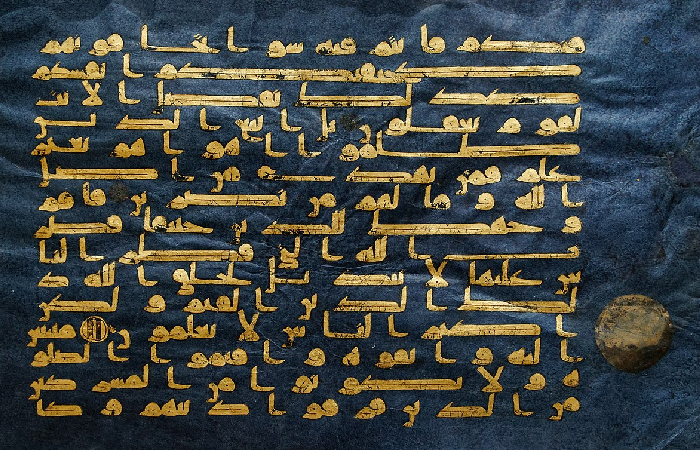
This amazing and one-of-a-kind piece of Islamic art is written in gold and silver ink. Dyed blue paper from the ninth century is used to write it. Ali ibn Abi Talib, the Prophet Muhammad's cousin and son-in-law, is thought to have owned it. The book is now on display at Istanbul's Topkapi Palace Museum.
- The Shah Jahan Nama The Shah Jahan Nama is a chronicle of Mughal emperor Shah Jahan's reign.
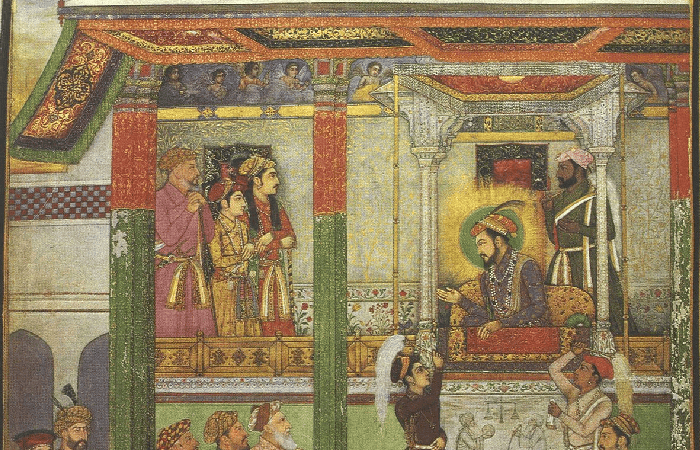
The book has several magnificent examples of Arabic calligraphy, including work by renowned calligrapher Mir Ali al-Katib. The Shah Jahan Nama is now held in London's British Library.
The Muraqqa Gulshan is a collection of miniature paintings and calligraphy by Mughal artists.
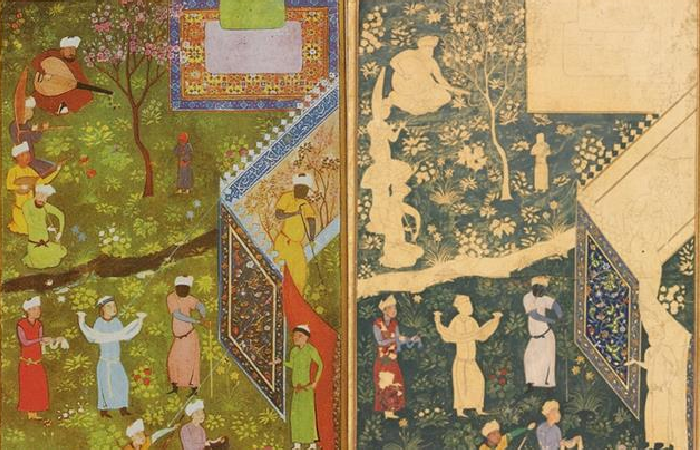
The book was created in the 17th century by Mughal emperor Jahangir and includes works by some of the most notable calligraphers of the day, including Mir Ali al-Katib and Hafiz Muhammad Amin. The Muraqqa Gulshan is now on display at India's National Museum in New Delhi.
These are just a few of the many notable pieces of Arabic calligraphy that can be found all over the world. Each piece tells a different story and exemplifies the remarkable skill and artistry of Islamic calligraphers.
Ethical And Halal Considerations In Arabic Calligraphy
When practicing Arabic calligraphy, as with any other art form, certain ethical and halal factors must be taken into account. Here are some crucial points to remember:
Understanding Ethical And Halal Guidelines In Calligraphy
Ethical Considerations:
-
The substance of calligraphy should be encouraging and uplifting. Avoid using abusive language, making discriminatory statements, or inciting violence or hatred.
-
Sincerity and genuineness are essential. If you are copying or referencing prior works, be careful to give due attribution and respect copyrights.
-
Calligraphy should be utilized for good. Avoid utilizing it for personal benefit or to promote unethical practices.
Halal Considerations:
-
Religious calligraphy, such as Quranic verses or devotional passages, must follow strict requirements. This could entail using certain materials, adhering to established practices, and gaining proper authorization from religious authorities.
-
Avoid utilizing calligraphy for activities that are considered disrespectful or Haram (forbidden) in Islam. This includes linking it with idolatry, magic, or behaviors deemed dangerous or unethical.
-
Keep in mind your intended audience. When creating calligraphy for public exhibition, consider whether it may contain imagery or references that are objectionable or improper for particular people.
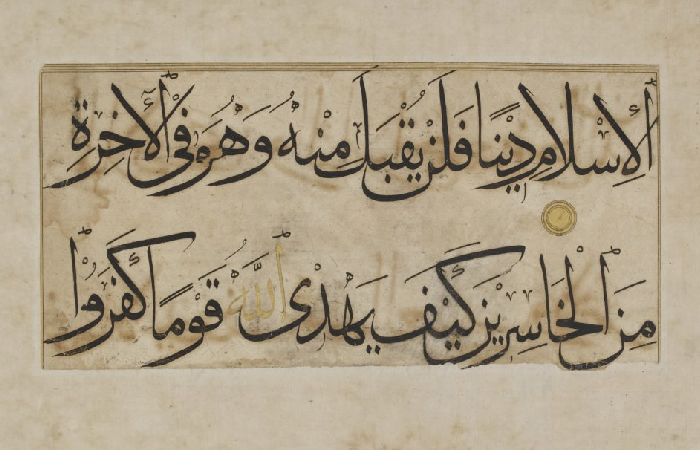
Religious And Cultural Sensitivities In The Art Form
With its rich beauty and deep spiritual meaning, Arabic calligraphy requires respect and deliberate effort to avoid unintended injury or contempt. While artistic expression thrives on discovery and creativity, several factors must be considered before embarking on this sacred art form.
Arabic calligraphy highlights the beauty and historical significance of each inscribed word, allowing one to visually traverse the depth and breadth of its meaning.
These scriptural renditions go beyond mere text to provide a comprehensive visual experience – each beautifully produced stroke tells a story, just the way a painting elicits a wide range of emotions and storylines.
Your artwork has the potential to inspire, uplift, and reflect the beauty of Islam. Your Arabic calligraphy can become a powerful instrument for cultural knowledge and artistic expression if you practice with awareness, respect, and ethical considerations.
Its therefore essential for the artist to keep all these considerations in mind before creating their masterpiece.
Conclusion
Arabic calligraphy, a timeless art form, has bridged the historical gap between its basic purpose in preserving Islamic teachings and its modern-day aesthetic attractiveness.
-
It not only transmits messages but does so with incomparable elegance and beauty, as it is rooted in profound spiritual importance. Today's increasing global interest, as seen by exhibitions and its pervasive presence in modern decor, attests to its enduring allure.
-
As calligraphers continue to use their pens to bring words to life, Arabic calligraphy serves as a witness to the peaceful union of faith, history, and art. In an ever-changing world, the art of Arabic calligraphy is a steadfast beacon of tradition, culture, and spirituality.
-
The appeal of Arabic calligraphy isn't limited to displays in modern settings. Many people are captivated to the spiritual nature of calligraphy and want to decorate their homes and offices with it.
-
These pieces are thought to fill areas with a good aura and promote a tranquil atmosphere, harmonizing with the profound meanings they convey.
Links to Resources, Tools, and Classes for Further Learning
https://en.wikipedia.org/wiki/Naskh_(script)
https://en.wikipedia.org/wiki/Arabic_calligraphy
https://en.wikipedia.org/wiki/Kufic
https://www.skillshare.com/en/blog/a-brief-history-of-arabic-calligraphy/#tools-used-for-arabic-calligraphy
https://al-dirassa.com/en/importance-of-arabic-calligraphy-art/
https://www.arabic-calligraphy.com/the-importance-of-calligraphy-in-islamic-art/
https://www.arabic-calligraphy.com/arabic-calligraphy-tools/
https://www.britannica.com/story/8-masterpieces-of-islamic-architecture
https://www.arabic-calligraphy.com/calligraphy-generator/
https://en.unesco.org/silkroad/content/topkapi-palace-museum
https://ich.unesco.org/en/RL/arabic-calligraphy-knowledge-skills-and-practices-01718
https://www.thehindu.com/society/history-and-culture/arabic-calligraphy-thrives-in-bengaluru-institute/article33877330.ece
https://majnouna.com/courses/
https://elseed-art.com/
https://www.hudabeydoun.com/
Who Is the Most Famous Arabic Calligrapher?
Ibn Muqla is the most famous Arabic calligrapher. He is regarded as the father of Islamic calligraphy. Many islamic calligraphers has taken inspiration from him.
Other famous calligraphers are:
- Mir Ali Tabrizi.
- Yaqut al-Musta'simi.
- Mustafa Ja'far.
- Sheikh Hamdullah.
- Hasan Çelebi.
- Abu Ali al-Qali.
- Muhammad ibn al-Wahid.
